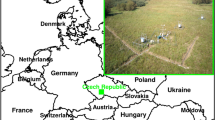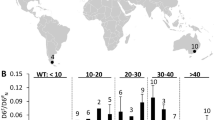Abstract
IN plants with crassulacean acid metabolism (CAM), CO2 is fixed in the light by ribulose-l,5-bisphosphate carboxylase1,2 and in the dark by phosphoenol pyruvate (PEP) carboxylase2,3. Because these two enzymes fractionate the stable isotopes of carbon (12C and 13C) in the atmosphere and discriminate against 13C to different extents4, the wide range of values of carbon isotope discrimination ratios (δ13C) found in these plants5 has been attributed to different contributions of dark and light fixation to carbon gain6. The proportion of total carbon fixed at night can be altered by environmental variables such as temperature7, water status8 and photoperiod5. Predictable changes in δ13C values have been observed when these environmental conditions have been varied. With one exception, all such studies have been performed in artificial conditions. Because the δ13C ratio of CAM plants has been used as an indicator of environment in palaeoecological investigations9, we have examined the sensitivity of these δ13C ratios to seasonal environmental influences in a natural system. Using Opuntia acanthocarpa, O. basilaris and O. bigelovii, we found that the carbon isotope composition of the plants did not change during the experiment, indicating the insensitivity of this measurement to short term seasonal influences in this environment.
This is a preview of subscription content, access via your institution
Access options
Subscribe to this journal
Receive 51 print issues and online access
$199.00 per year
only $3.90 per issue
Buy this article
- Purchase on Springer Link
- Instant access to full article PDF
Prices may be subject to local taxes which are calculated during checkout
Similar content being viewed by others
References
Osmond, C. B., et al., Nature, 246, 41 (1973).
Osmond, C. B., and Bjorkman, O., Aust. J. Pl. Physiol., 2, 155 (1975).
Sutton, B. G., and Osmond, C. B., Pl. Physiol., Lancaster, 50, 360 (1972).
Whelan, T., Sackett, W. M., and Benedict, C. R., Pl. Physiol., Lancaster, 51, 1051 (1973).
Allaway, W. G., Osmond, C. B., and Troughton, J. H., in Proc. R. Soc. N.Z., 12, 195 (1974).
Lerman, J. C., Deleens, E., Nato, A., and Moyse, A., Pl. Physiol., Lancaster, 53, 581 (1974).
Neales, T. J., Aust. J. biol. Sci., 26, 705 (1973).
Bartholomew, B., Photosynthetica, 7, 14 (1973).
Troughton, J. H., Wells, P. O., and Mooney, H. A., Science, 185, 610 (1974).
Craig, H., Geochim. cosmochim. Acta, 3, 53 (1953).
Szarek, S. R., Johnson, H. B., and Ting, I. P., Pl. Physiol., Lancaster, 52, 539 (1973).
Szarek, S. R., and Ting, I. P., Pl. Physiol., Lancaster, 54, 76 (1974).
Author information
Authors and Affiliations
Rights and permissions
About this article
Cite this article
SUTTON, B., TING, I. & TROUGHTON, J. Seasonal effects on carbon isotope composition of cactus in a desert environment. Nature 261, 42–43 (1976). https://doi.org/10.1038/261042a0
Received:
Accepted:
Issue Date:
DOI: https://doi.org/10.1038/261042a0
This article is cited by
-
Canopy CO2 concentrations and Crassulacean acid metabolism in Hoya carnosa in a subtropical rain forest in Taiwan: consideration of CO2 availability and the evolution of CAM in epiphytes
Photosynthetica (2006)
-
Effects of seasonal changes in the Midwest on Crassulacean Acid Metabolism (CAM) in Opuntia humifusa Raf
Oecologia (1980)
-
Carbon assimilation patterns and growth of the introduced CAM plant Opuntia inermis in Eastern Australia
Oecologia (1979)
-
Seasonal shift from C3 photosynthesis to Crassulacean Acid Metabolism in Mesembryanthemum crystallinum growing in its natural environment
Oecologia (1978)
-
Irrigation magnifies CAM-photosynthesis in Opuntia basilaris (Cactaceae)
Oecologia (1978)
Comments
By submitting a comment you agree to abide by our Terms and Community Guidelines. If you find something abusive or that does not comply with our terms or guidelines please flag it as inappropriate.



